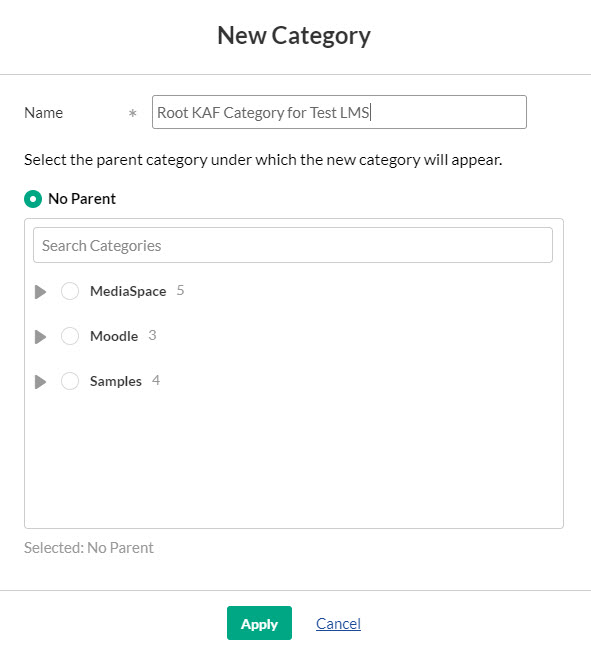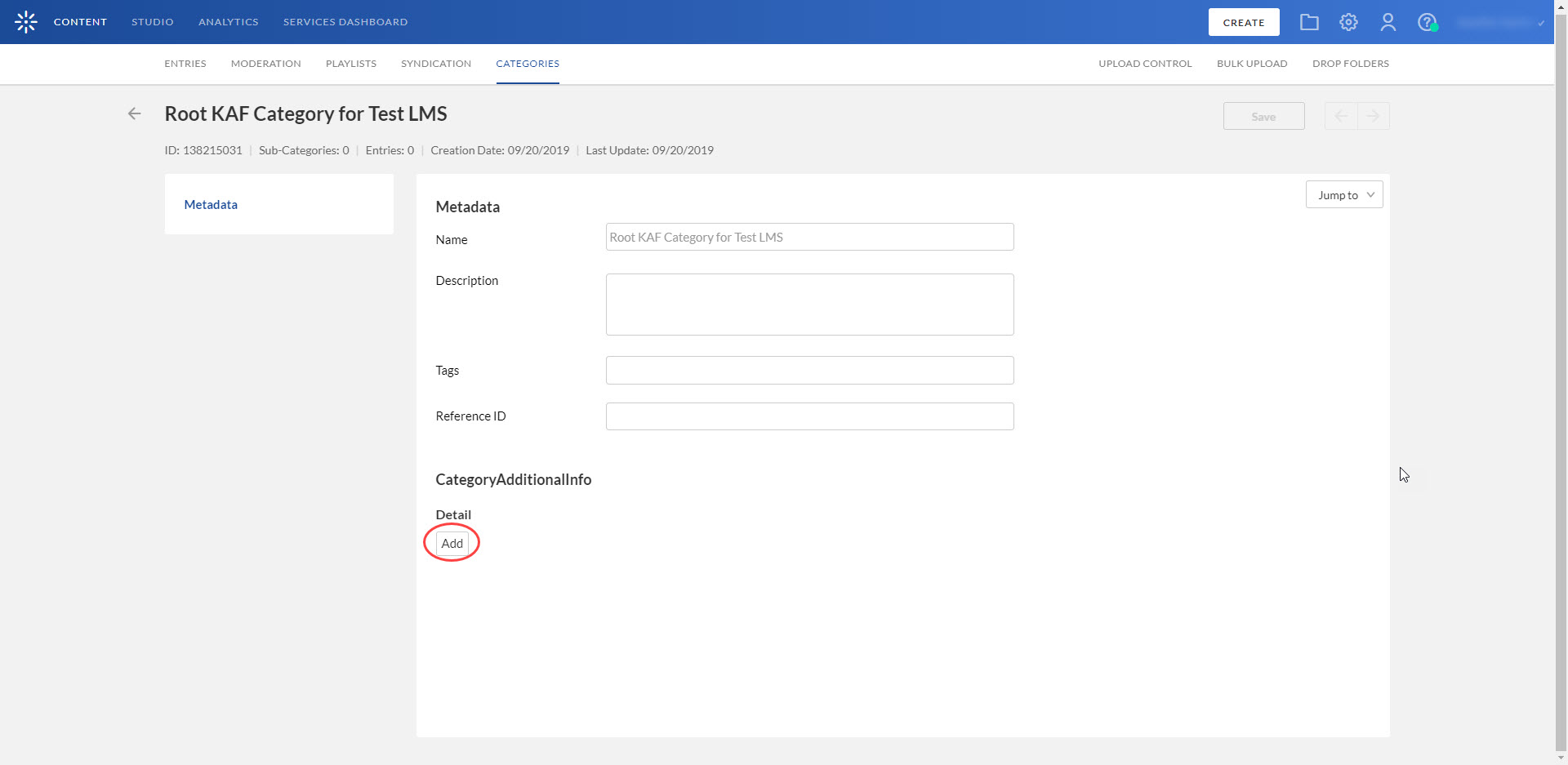This guide describes how to setup the Kaltura Video Building Block for Blackboard Learn. Instructions are provided for setting up the package behavior and how to control user roles and permissions using the Kaltura Application Framework (KAF) Admin Console.
Prerequisites
The following items are required to setup the Kaltura Video Building Block for Blackboard:
- Access to a Blackboard Learn environment with system administrator permissions.
- A Kaltura account - Please contact your Kaltura representative for your Kaltura account details.
- Deployment of the Kaltura Video Building Block for Blackboard Learn on your environment. For installation instructions, see Kaltura Video Building Block for Blackboard Learn Installation and Upgrade Guide.
- KAF Admin Console – please ask your Kaltura representative for credentials to access your KAF Admin Console instance.
Before You Begin
You will need to create a Blackboard root category in the KMC, if not already created for you by your Kaltura representative.
To create the Blackboard root category in the KMC
- Log into the KMC.
- Select the CONTENT tab and then select the CATEGORIES tab. The Categories Window displays.

- Click the Add Category button. The New Category Window displays.

- Type a Name for the new category and select the position of the root category.
- Click the Apply button. The Metadata Window displays.

- Type a Description, Tags, and a Reference ID for the new category.
- In the Category/AdditionalInfo section below Detail, click the Add button.
- Type Key and Value entries.
- Click the Save button. Your new category now shows in the list of categories on the Categories Window.

Mandatory Configuration
After installing the Kaltura Video Building Block for Blackboard Learn, you will need to specify the root category you created under the Categories module.
Module | Fields | Description |
Categories | RootCategory | Select the category you created in the KMC. |
The root category should not be changed after the plugin is configured. It is okay to change the name of the root category in the KMC. It will automatically update in the KAF Admin Console.

Be certain that the sharedRepositoryCategoryId field is updated in the Hosted module. If it is not updated, the following message is displayed.

Click "Click here to update" to updated the Shared Repository.
This step is only required one time after installation or migration of the Kaltura Video Building Block for Blackboard Learn.
Understanding the Setup Process
The Kaltura Video Building Block for Blackboard Learn offers an out-of-the-box solution that enables users to view, record, upload, publish, search, and share video directly from their Blackboard environment. This translates into time and money saved for your organization, improved student engagement, creativity and learning results, as well as ease of use for students, faculty and teaching assistants.
The Kaltura Application Framework (KAF) Admin Console
The Kaltura Video Building Block for Blackboard Learn is implemented on top of the Kaltura Application Framework (KAF), a feature rich framework that allows flexible and streamlined integration of Kaltura’s video solutions and products into 3rd party applications such as Blackboard. KAF is hosted and served directly from the Kaltura cloud servers and once integrated into your Blackboard environment, presents different video components and workflows to users.
At the back end, the Kaltura Application Framework provides a flexible and extensible administration panel, called “KAF Admin Console”. The KAF Admin Console offers full control over the user experience and when interacting with videos inside Blackboard. Nearly all configuration aspects of the Kaltura Video Building Block for Blackboard Learn are configured through the KAF Admin Console.
KAF Modules
Your KAF instance is composed of multiple KAF modules, such as “Application”, “Player”, and “Auth”. Each module controls a different aspect of your Kaltura Video Building Block for Blackboard Learn instance. A KAF module is composed of a set of configuration fields. All KAF modules are listed on the left menu in your KAF Admin Console instance.

Your KAF Admin Console may display modules and configuration fields that are not listed in this guide, some of which may be disabled. It is important that you do not modify the configuration of the disabled modules (and not enable them) without consulting with your Kaltura representative.
KAF Administration: Actions and Configurable Fields
Your KAF account comes pre-configured with the following settings. Items marked with * should not be changed.
General Settings
Module | Fields | Description |
InstanceId, privacyContext, userRoleProfile | Internal constant identifiers of your KAF instance. Please note that privacyContext should be empty. | |
sslSettings | All site (set to None if SSL is not used) | |
| Client | serviceURL | https://www.kaltura.com(set tohttp://www.kaltura.comif SSL is not used) |
| VerifySLL | Yes (set to No if SSL is not used) | |
allowLoadInIframe | Yes* | |
| enabled | Yes (set to No if you want to disable the Faculty Repository) | |
enabled | Yes* | |
enabled | Yes* | |
enabled | Yes* | |
Blackboard | enabled | Yes* |
enabled | Yes* | |
enableLike | Yes/No Please note that entries may only be 'liked' from their corresponding media page. | |
enableViews | Yes/No | |
allowEditPublished | Set toNoif you want to prevent users from editing entries after they have been published to a course Media Gallery or embedded using the Browse, Search and Embed module. | |
allowDeletePublished | Set toNoif you want to prevent users from deleting entries after they have been published to a course Media Gallery or embedded using the Browse, Search and Embed module. | |
enableEntryDelete | Set toNoto completely prevent users from deleting entries | |
manPublish | Yes* (Unless publish plugin was integrated). | |
authMethod | Lti |
Configuring Modules
Some fields are displayed only when you select a specific value for a different field. The group's configurable fields follow the group name.
To modify KAF configuration modules
In the KAF Admin window select the Manage Configuration tab.
Related KAF modules: Application, Auth, Client, Security, Categories, Addcontent, Publish, Browseandembed, Blackboard, Hosted
The following KAF modules are required for configuring the Kaltura Video Building Block for Blackboard Learn and are described in this guide:
Configuration Management: Global Modules
Configuration Management: Configuration Modules
Configuration Management: Entry Type Modules
Modules/Custom/Core/KAF
Roles and Permissions
See Common Use Cases of Role Configuration for recommendations for common role configurations in the Kaltura Video Building Block for Blackboard Learn.
Introduction to Role Mapping
The Kaltura Video Building Block for Blackboard Learn implements role mapping from Blackboard roles to Kaltura roles via LIS roles. Each role that is assigned to a user in Blackboard is mapped to one of the roles defined in the LIS standard. When a user is assigned with a role in a Blackboard site – Student or Teacher for example –Blackboard translates this role to an LIS role which is then sent to KAF. On KAF’s side, a dedicated module provides flexible mapping between LIS roles and Kaltura roles, allowing a granular control over the behaviour of the different Kaltura Video Package components in Blackboard.
This process is described in the following workflow.
- Users are assigned a Blackboard institution, System, or course-level role.
- The Building Block maps the corresponding LIS role to Kaltura.
- KAF Grants Permissions according to mapping.
Assigning Roles in Blackboard Learn
To learn more about roles management in Blackboard Learn, please refer to this manual.
Mapping Blackboard Learn Roles to LIS Roles
The Kaltura Building Block maps institution, system and course-level roles to LIS roles based on mapping tables that are available under the building block setting page. Login as a System Admin in Blackboard Learn then go to System Admin > Building Blocks > Installed Tools > Kaltura Integration > Settings > Kaltura Video Building Block Role Mapping.
The following options appear:
Institution-Wide Role Mapping
This table allows you to choose the role mapping for users outside of the context of a course. The default institution role mapping is provided. Each row represents a Blackboard Learn Institution role, and each column represents the possible LIS roles.

When new custom Institution Roles are added in Blackboard Learn, they automatically appear in the table.
Send Administrator Role?
Check this option if you want to send the LIS role “Administrator” to the Blackboard Learn System Administrator.
When checked, the Administrator role will be sent for Blackboard System administrators regardless of their Institution or Course-level roles. Use this option to enforce role mapping override for system administrators.
Other system roles are not mapped by the Kaltura Building Block by default.
Send Secondary Roles?
Check this option if you want the Kaltura Building Block to send secondary Institution roles.
In case more than one LIS roles are sent to KAF, the highest level role will be used.
System-Wide Role Mapping
The following table allows you to choose the role mapping for users outside of the context of a course in addition to the Institution-wide role mapping. When Institution roles are not available, system roles may be used to map roles outside of course context. Each row represents a Blackboard Learn System role, and each column represents the possible LIS roles. The default settings do not send system roles. System Roles should be used only in cases where Institution roles are not available.

When new custom System Roles are added in Blackboard Learn, they automatically appear in the table.
Send System Roles?
Check this option if you want the Kaltura Building Block to send the system roles mapping to KAF. In case more than one LIS roles are sent to KAF (Institution roles and System roles mapping), the highest level role will be used.
Send Secondary Roles?
Check this option if you want the Kaltura Building Block to send secondary System roles.
In case more than one LIS roles are sent to KAF, the highest level role will be used.
Course-Level Role Mapping
This table allows you to choose the role mapping for users inside the context of courses. The default institution role mapping is listed.

KAF Grants Permission According to the Mapping
On the KAF Admin Console side, each LIS role can be mapped back to Kaltura roles. KAF grants different permissions according to the mapping provided in the Hosted module in the KAF Admin Console:

As displayed, each LIS role is mapped in Kaltura to two roles – an Applicative Role (kmsRole) and a Contextual Role (kmsContextualRole). These roles correspond to different cases/scenarios in the Kaltura Application Framework Generic LTI Integration. Setting these roles changes the permissions a user has in the following scenarios:
- Applicative role (KMSRole) - Defines the user roles and permissions in Kaltura widgets that are out of course context (for example: My Media)
- anonymousRole – Not relevant to the Kaltura Application Framework Generic LTI Integration and should not be used.
- viewerRole – The user will not have access to My Media, and will not be able to upload new content to either My Media, Media Gallery or using the Embed Kaltura Media text-editor button.
- privateOnlyRole – The user will have access to My Media and will have the ability to create new content.
- adminRole, unmoderatedAdminRole – Not relevant to the Kaltura Application Framework Generic LTI Integration and should not be used.
- Contextual role (KMScontextualrole) - Defines the user roles and permission in Kaltura widgets when in a course (site) context (for example: Media Gallery)
- Member: The user will be able to view content in Media Galleries of courses to which the user is enrolled, but will not be able to contribute (publish) to the galleries.
- Contributor: The user has Member permissions with the ability to publish content to the Media Gallery.
- Moderator: The user has Contributor permissions with the ability to moderate content added to the Media Gallery.
- Manager: The user has Moderator permissions with the ability edit the Media Gallery settings, and view the course gallery analytics.
From the Kaltura module’s perspective, the permissions are as follows:
- My Media
- Applicative role: If viewerRole, the user will not have access to My Media and will not be able to upload new content. If privateOnlyRole the user will be able to have its own My Media repository to where he can upload his own private content.
- Contextual role: does not impact My Media.
- Media Gallery
- Applicative role: If the user has a contextual role that allows publishing/adding content to the Media Gallery (see the following table), and the user has an Applicative role of privateOnlyRole, the user will be able to upload new content or contribute content from its own private My Media repository.
- Contextual role: Determines the role of the user inside the Media Gallery (note – users can access a course Media Gallery after they have access to the course page in the LMS, regardless of their Kaltura role.
Role | Permissions |
Member | If the user has Member contextual role, the user will be treated as a “viewer only” in the Media Gallery, and will only be able to view content, and will not be able to contribute content to the Gallery (regardless of the user’s Applicative role). |
Contributor | Users with Contributor role can view Media Gallery entries and upload and contribute entries from My Media (if applicative role is privateOnlyRole). Students are usually assigned Member or Contributor contextual roles. |
Moderator | Moderator role allows the users to moderate content published to a Media Gallery (and to contribute new content). Teaching Assistants usually have Moderator contextual roles. |
Manager | A Manager role provides full access to the Media Gallery, including the ability to moderate content, edit the Media Gallery’s settings and metadata, and access the Media Gallery Analytics. Instructors usually have Manager contextual roles |
- Browse, Search and Embed (rich-text editor button)
- Applicative role: If viewerRole, the user will not have access to My Media and will not be able to create new content. If privateOnlyRole the user will be able to have their own My Media repository to where they can upload their private content.
- Contextual role: does not impact Embed Kaltura Video.
Common Use Cases of Role Configuration
This section provides recommendations for common role configuration in the Kaltura Video Building Block for Blackboard Learn.
The following use cases are described:
- Allowing Students to Upload Content
- Allowing Faculty Only to Upload and Create New Content
- Creating a Teachers Only Faculty Repository
Allowing Students to Upload Content
Allow all Blackboard Learn users to author new content (upload, webcam recording, screencast recording, etc.) and publish to courses, Media Galleries, regardless of their contextual role.
Blackboard Learn Side Configuration
- Map students’ institutional (and/or system) and course-level roles to Learner.
- Make sure the My Media Module is available to all users: As a system administrator go to System Admin > Tabs and Modules > Modules > My Media > Module Properties and set the module availability under the Availability section:

KAF Side Configuration
In your KAF instance, configure the following mapping under the Hosted module:
ltiRole | kmsRole | kmsContextualRole |
Learner | privateOnlyRole | CONTRIBUTOR |
| Instructor | privateOnlyRole | MANAGER |
Allowing Faculty Only to Upload and Create New Content
Allow only faculty members to create and upload new media. Students should not have access to My Media and should not be able to contribute to any course Media Gallery.
Blackboard Learn Side Configuration
To accomplish this configuration, the My Media link should be available only to faculty members. It is important to hide the My Media link - if students are able to access the My Media link, an “Access Denied” message will be displayed as they are prevented from accessing My Media by the KAF-side configuration (see below).
To hide My Media from students
- Log into Blackboard Learn as a system administrator.
- Go to System Admin > Tabs and Modules > Modules > My Media > Module Properties.
- Under Available To, choose "Specific Roles" and select the desired roles. Make sure that Student is not included.

KAF Side Configuration
In your KAF instance, configure the following mapping under the Hosted module:
ltiRole | kmsRole | kmsContextualRole |
Learner | viewRole | MEMBER |
| Instructor | privateOnlyRole | MANAGER |
Creating a Teachers Only Faculty Repository
Creating a cross-site, shared repository accessible to faculty only. Only faculty members will have the capability to share common files among multiple courses.
For more information on the Faculty Repository, please refer to Kaltura Video Building Block 5 for Blackboard Learn 9.x User Manual.
Blackboard Learn Side Configuration
Add the Faculty Repository module to the Institution homepage and make it available to Faculty members only.
To add the Faculty Repository Module to the Institution Home Page
- Log into Blackboard Learn as a system administrator.
- Under My Institution click the Add Module button.
- Under Other look for the Faculty Repository module and click Add.
- Click OK.
To hide the Faculty Repository module from students
- Log into Blackboard Learn as a system administrator.
- Go to System Admin > Tabs and Modules > Modules > Faculty Repository > Module Properties.
- Under Available To, choose "Specific Roles" and select the desired roles. Make sure that Student is not included.

KAF Side Configuration
In the Hosted module turn off the shared repository for the Learner LTI role if enabled.







